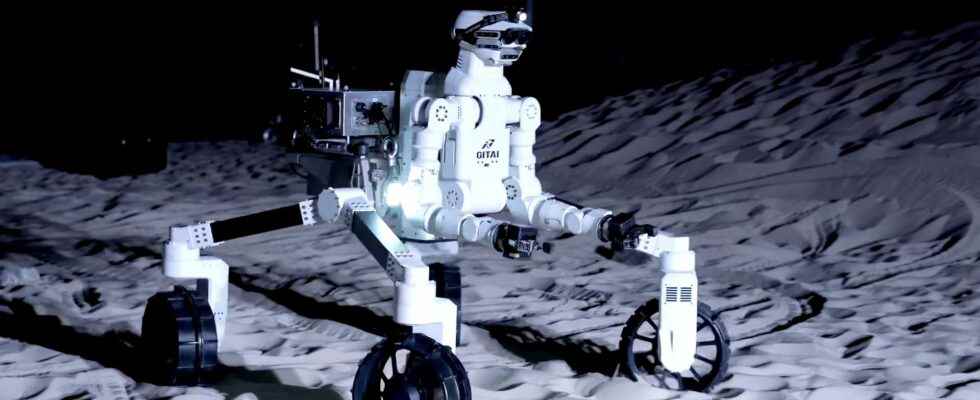In December 2021, the Japanese robotics company Gitai was testing its R1 rover, commissioned by Jaxa and intended to travel to the Moon. A video, published a few months later, makes it possible to admire the capabilities of the device in realistic conditions reproducing the characteristics of the lunar regolith.
In parallel with the Artemis program, some space agencies are preparing their next arrival on the Moon with rovers. This is the case of the japanese space agency in partnership with the Japanese firm specializing in robotics, Gitai. In September 2020, Jaxa announced the establishment of a collaboration with the private company, with the aim of designing robots assigned to carry out missions in space.
To this end, Gitai has developed a multifunction rover, soberly called R1. In December 2021, the capabilities of R1 were tested in realistic conditions, on a surface mimicking a plain on the Moon and its specificities. In a video published in February 2022, the robot impresses with its fluidity and its capabilities. The rover can thus easily maneuver and change direction, overcome natural obstacles or even collect objects on the ground. The experiment took place at the Sagamihara campus in Japan.
A marvel of technology
R1 is equipped with four legs whose wheels, multi-directional, allow the rover to quickly adapt its position. The test demonstrates that the unit is able to overcome medium-sized obstacles and rocks, while raising or lowering the rover’s trunk. Thanks to its mobility, it can also climb slopes whose inclination is estimated between 15 and 20 degrees.
Two articulated arms placed at the front of the robot make it possible to carry out regolith collection operations on the ground. Grippers positioned at the end of the arms can use a small shovel to drop lunar dust samples into a container which is then sealed by the rover before being stored in a container. The arms, split into several parts, give R1 a wide range of motion. Controlled remotely by an engineer, the device performs precise and technical gestures: it can easily detach a strap from a package, move and use tools. Gitai exhibits its know-how by having its rover built a communication relay and a set of solar panels. R1 executes with precision the movements required for the assembly of the structure, by screwing the supports or by adjusting the position of the solar panels.
R1, more efficient than a human?
The cooperation established between Jaxa and Gitai aims to democratize robotic missions to space and the Moon. L’japanese space agency wants to oversee operations with reduced financial cost, with robots working efficiently where humans could not go. On his site Internetthe Japanese company reveals its ambition: participate in the construction of lunar bases and Martians as early as the 2040s and beyond.
Regarding the R1 rover, the impressive technical demonstration of December 2021 should confirm the Japanese space administration in its ambition for robotic missions to the Moon. Gitai indicates under the video presentation of the rover that the latter could quickly make its first turns in the lunar dust, as early as 2025.
Special offer: for Father’s Day, offer the best of Science!
Your father is a great science enthusiast and unusual discoveries? And if you offer him a superb scientific exploration in paper format? Benefit from -20% on the Mag Futura (special offer: €15 instead of 19 €): 220 pages to explore 4 scientific issues that will shape our future!
Mag Futura is:
- 4 major scientific questions for 2022, from the Earth to the Moon
- 220 pages, 60 experts: no fake news, just science
- Home delivery with electronic gift card
- An independent scientific media
Interested in what you just read?
